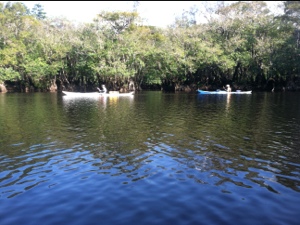Rob Diaz de Villegas WFSU-TV
On every RiverTrek Day wrap-up post I wrote about what I heard while I lay in my sleeping bag that morning. This morning it was the buzzing of my alarm, and then I strained to hear anything else. Walls do a much better job keeping sound out than the thin fabric of a tent. Eventually I hear that gentle hum of cars and trucks. Today’s trash day, so I know garbage and recycling trucks are coming.
 Back to a more technologically civilized existence. That means I can upload all the posts that wouldn’t make it from the tablet while using Rick’s or Micheal’s phones as hotspots. And I can add a lot more photos. The blog software lets you fudge the dates, so everything can show up in order and you can start at the beginning and look at what we saw along the way. The best way to see it all would be to go back to what is currently page 3 and keep scrolling over the posts (every new post will push them down, so this won’t be true for more than a few weeks). Or you can just jump to the beginning and go post by post.
Back to a more technologically civilized existence. That means I can upload all the posts that wouldn’t make it from the tablet while using Rick’s or Micheal’s phones as hotspots. And I can add a lot more photos. The blog software lets you fudge the dates, so everything can show up in order and you can start at the beginning and look at what we saw along the way. The best way to see it all would be to go back to what is currently page 3 and keep scrolling over the posts (every new post will push them down, so this won’t be true for more than a few weeks). Or you can just jump to the beginning and go post by post.
I am fortunate and honored that I was invited to participate in this year’s event. I hope we do it justice in these posts and in the two video segments set to air on WFSU’s dimensions program (and which I’ll post here). There may be other bits and pieces to post as well. We saw and learned a lot.
And I do want to thank everyone who helped me with the production side of things. Georgia already thanked the support team, and I want to reiterate that. Thanks Eddie, Mitch, Fred, Dawn and Rick. Thanks as well to Captain Gill on the support boat, and a big thanks to Dan Tonsmeire for taking a videographer for two days and showing him the river (and for so many other things as well).
Thanks to WFSU videographer Dan Peeri and In the Grass, On the Reef Associate Producer Rebecca Wilkerson for your assistance on the production side of things.
Thanks to the paddlers for putting up with the cameras, my lagging behind when I went to get a shot, and the occasional bump from my boat. And for making me feel welcome in this group. Thanks to Rick and Micheal for the use of your phones as WiFi hotspots. A big thanks to Georgia for posting diligently and keeping the outside world up to date when technology failed me. Georgia and Doug Alderson did a fantastic job coordinating the trip and picking participants. I can’t say enough about the experience of RiverTrek, and how much there was for us to shoot and write about.
Lastly, I want to thank my wife Amy for letting me go for five days and staying home with an increasingly active toddler.
I’m probably forgetting someone. If I am, these posts are editable.
